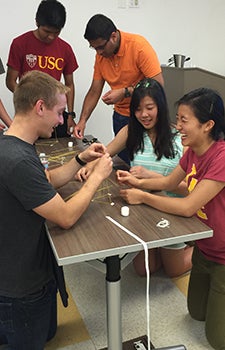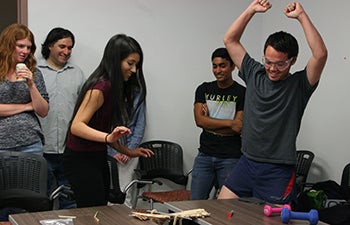
Students learn to think and work together on a wicked problem
Tightly clutching her pipette, undergraduate researcher Stephanie Loekman carefully performed a DNA-related experiment under the watchful eye of her mentor Johannes (Jan) van Dijk. Loekman, a junior majoring in health promotion and disease prevention and psychology at USC Dornsife, was keen to keep a firm grip on the laboratory instrument for accuracy’s sake. But when she handed it to van Dijk, a doctoral student at USC School of Pharmacy, he questioned her technique.
“Do you feel how warm this pipette is?” he asked.
“Is that an issue?” replied Loekman. “I didn’t know the temperature of the pipette mattered.”
“It does,” van Dijk responded. “If you hold it too tightly you make it too warm and accuracy decreases.”
Loekman got this valuable lesson in the correct handling of laboratory equipment as she started at the Bridge UnderGraduate Science (BUGS) Program this summer. Now in its second year, the program aims to change the way research is taught to undergraduate and high school students, increasing collaboration among the next generation of researchers.

Lea Fang (right) and other BUGS participants participate in a team building activity. Photo courtesy of Angela Walker.
Researchers at the Bridge Institute at the USC Michelson Center for Convergent Bioscience are building a dynamic, atomic-resolution, computational model of the human body to understand and improve the human condition.
“We want to move away from the silo-driven approach to a more collaborative and team-oriented approach toward solving wicked problems,” said Raymond Stevens, Provost Professor of Biological Sciences and Chemistry, professor of neurology, physiology and biophysics, and chemical engineering and materials science, and director of the Bridge Institute. “We want to show the next generation of students that it is both productive and fun to collaborate in science.”
The BUGS Program welcomed 29 undergraduates and 15 students from nine different high schools to participate in custom, individualized research projects over the summer. Mentors from 14 research laboratories at the Bridge Institute guided the students through research techniques and problem solving.
Loekman spent the summer working with scientists who are collaborating with the NASA Space Biology Program on a new research project at the intersection of pharmaceutical sciences and human space exploration.
Praising Van Dijk’s patience and skill as a mentor, she said, “Jan has taught me everything I know. He trained me, polishing me like an Olympian. He made sure I understand that every single thing I do affects my results.”
Loekman and her fellow scientists in training also participated in lab meetings, read and discussed scientific articles in a journal club series and heard personal perspectives on the journey into scientific research in a special BUGS-focused series of career symposia. The program culminated in a symposium where students presented to peers, families and guests, as well as Bridge Institute faculty, mentors and staff.
Cross-disciplinary research
Loekman believes the type of cross-pollination fostered by BUGS is imperative to furthering scientific understanding.
“BUGS is a great way to get a holistic view of science. You really share your knowledge and I think that’s beautiful.”
Paying tribute to BUGS, USC Provost Michael Quick said, “We cannot survive the 21st century if we do not innovate our way out of it. Training the next generation by giving them hands on understanding of what it means to do science at the cutting edge is the most important thing a research university can do.”
Next year, the program plans to increase enrollment to 100 participants.
Loekman was already a USC Dornsife Summer Undergraduate Research Fellow (SURF) in the laboratory of Clay C. C. Wang, professor of pharmacology & pharmaceutical sciences at USC School of Pharmacy and professor of chemistry at USC Dornsife, when she decided to join BUGS on Wang’s recommendation.

C.C. Wang, second from right, stands with (from left) Bethany Chen, Ada Li, Stephanie Loekman and Joy Ahn, all BUGS participants in his lab. Photo courtesy of Stephanie Loekman.
Loekman worked with scientists who are sending fungi spores to the International Space Station to investigate the effects of microgravity in fungal growth. The goal? To turn on silent pathways for the discovery of novel compounds that could be used to create clinically useful drugs.
Pushing the boundaries
Fellow BUGS participant Lea Fang, a senior majoring in health and human sciences at USC Dornsife, also took part in frontline research. She joined BUGS on the recommendation of Andrea Armani, associate professor of chemistry at USC Dornsife, associate professor of chemical engineering and materials sciences at USC Viterbi School of Engineering, and a part of the Michelson Center.
Originally majoring in biomedical engineering at USC Viterbi, Fang continued to work in the Armani Research Lab after switching majors, but was curious to learn more about other types of research on campus.
“I definitely got a better insight into what a career path in research would be like,” she said. “Although I originally wanted a more hands-on approach for the occupational therapy degree I plan to do when I graduate, BUGS has made me excited about the idea of scientific research. Now I’m considering doing clinical research.”
Fang’s research project focused on a polarimetric stress-inducing device developed by the Armani Research Lab. Her role: to test its efficacy using fish samples.

In another team building activity, BUGS participants try to build the tallest tower possible using raw spaghetti, string and tape. The finished structure must support a jumbo marshmallow. Photo courtesy of Angela Walker.
“We call it the ‘tissue squisher,’” Fang said. “Using the concept of polarization and optics, it enables us to sense the stiffness, or the Young’s modulus, of an object placed on top of an optical fiber.”
As tumors are stiffer than non-tumorous areas, the device is intended to help physicians determine cancerous areas within a tissue sample. This could help ensure they remove all of it during surgery.
Fang’s mentor was Alexa Hudnut, a graduate student in biomedical engineering at USC Viterbi.
“Students who are interested in meeting their peers, who are highly driven and want to be challenged by people with different ideas should definitely apply to BUGS,” Hudnut said. “It’s a great opportunity for students to get involved in research and develop their problem solving skills.”
Van Dijk agreed.
“BUGS gives students real life insight into actual research and the research world,” he said. “It allows them to apply proper laboratory conduct and techniques to real research that has unexpected results and provides a link between theory and practice.”
Loekman said she would definitely urge undergraduates to apply.
“BUGS provides a forum to discuss science while paying you to do what you love and learn about what others love, too. It opens up the possibility of so many different scientific paths and you don’t have to do the research yourself in order to understand them all. That’s the beauty of BUGS.”
Stevens concludes, “The detailed model of the human body across space and time will enable new visualizations of physiological processes in health and disease, observe the earliest stages of disease, and allow testing of developed therapeutics without invasive procedures or detrimental side effects. Our BUGS program is training the next generation to accomplish this goal.”